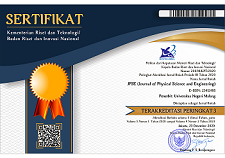Fabrication and Characterization of GO-Fe3O4/PSF Membrane with Phase Inversion Method
Abstract
Polysulfones are hydrophobic which can reduce membrane permeability. Permeability can be increased through the application of hydrophilic materials such as GO-Fe3O4 to the polysulfone membrane so that the membrane is hydrophilic. The riset purpose to determine the effect of the percentage weight of different material compositions on the hydrophilicity properties of the polysulfone membrane. Membrane fabrication is carried out using the phase inversion method where the polymer solution is molded in a place and immersed in a coagulation bath containing non-solvent. This solvent exchange causes the polymer to form a solid matrix and become a membrane. The results showed that GO particles were successfully doped with Fe3O4 material shown by XRD analysis at a peak of 35.61˚ with a magnetite phase, while FTIR analysis showed that there was an absorption band characteristic of Fe-O streching vibrations. The results of the contact angle test on the GO-Fe3O4/PSF membrane 0.75 wt per cent were around 73.17˚ which showed the smallest hydrophobic value and the membrane surface morphology had an average pore size of 333.61 nm so that the addition of GO-Fe3O4 composites could increase membrane hydrophilicity.
Keywords
Full Text:
PDFReferences
I. G. Y. Dewantara, B. M. Suyitno, and I. G. E. Lesmana, “Desalinasi Air Laut Berbasis Energi Surya Sebagai Alternatif Penyediaan Air Bersih,” J. Tek. Mesin, vol. 7, no. 1, p. 1, 2018.
A. Aende, J. Gardy, and A. Hassanpour, “Seawater Desalination: A Review of Forward Osmosis Technique, Its Challenges, and Future Prospects,” Processes, vol. 8, no. 8, p. 901, 2020.
N. C. Darre and G. S. Toor, “Desalination of Water: a Review,” Curr. Pollut. Rep., vol. 4, no. 2, pp. 104–111,2018.
B. Cai et al., “Mathematical study of spray flash evaporation in a spray-assisted seawater desalination chamber,” Desalination, vol. 465, pp. 25–37, 2019.
H. Zheng, “General Problems in Seawater Desalination,” in Solar Energy Desalination Technology, Elsevier, pp. 1–46, 2017.
J. Lyu, X. Wen, U. Kumar, Y. You, V. Chen, and R. K. Joshi, “Separation and purification using GO and r-GO membranes,” RSC Adv., vol. 8, no. 41, pp. 23130–23151, 2018.
A. Bankura, V. Carnevale, and M. L. Klein, “Hydration structure of salt solutions from ab initio molecular dynamics,” J. Chem. Phys., vol. 138, no. 1, p. 014501, 2013.
C. Zhong, Y. Deng, W. Hu, J. Qiao, L. Zhang, and J. Zhang, “A review of electrolyte materials and compositions for electrochemical supercapacitors,” Chem. Soc. Rev., vol. 44, no. 21, pp. 7484–7539, 2015.
L. Badrinezhad, S. Ghasemi, Y. Azizian-Kalandaragh, and A. Nematollahzadeh, “Preparation and characterization of polysulfone/graphene oxide nanocomposite membranes for the separation of methylene blue from water,” Polym. Bull., vol. 75, no. 2, pp. 469–484, 2018.
H. T. V. Nguyen et al., “Preparation and Characterization of a Hydrophilic Polysulfone Membrane Using Graphene Oxide,” J. Chem., vol. 2019, pp. 1–10, 2019.
H. Yuan, L. Jin, D. Luo, and C. Ge, “Modification Effect of Nano-Graphene Oxide on Properties and Structure of Polysulfone Ultrafiltration Membrane,” J. Environ. Prot., vol. 09, no. 11, pp. 1185–1195, 2018.
Y. You, V. Sahajwalla, M. Yoshimura, and R. K. Joshi, “Graphene and graphene oxide for desalination,” Nanoscale, vol. 8, no. 1, pp. 117–119, 2016.
S. Homaeigohar and M. Elbahri, “Graphene membranes for water desalination,” NPG Asia Mater., vol. 9, no. 8, pp. e427–e427, 2017.
R. Rezaee et al., “Fabrication and characterization of a polysulfone-graphene oxide nanocomposite membrane for arsenate rejection from water,” J. Environ. Health Sci. Eng., vol. 13, no. 1, p. 61, 2015.
G. Cheng, Y.-L. Liu, Z.-G. Wang, J.-L. Zhang, D.-H. Sun, and J.-Z. Ni, “The GO/rGO–Fe3O4 composites with good water-dispersibility and fast magnetic response for effective immobilization and enrichment of biomolecules,” J. Mater. Chem., vol. 22, no. 41, p. 21998, 2012.
H. Huang, “Graphene oxide nanosheet: an emerging star material for novel separation membranes,” J. Mater. Chem. A, p. 11, 2014.
S. Aprilia and M. Assaki, “Karakteristik Membran Selulosa Triasetat Yang Diprepasi Secara Inversi Fasa Presipitasi Imersi,” vol. 1, no. 1, p. 5, 2020.
P. V. Chai, E. Mahmoudi, Y. H. Teow, and A. W. Mohammad, “Preparation of novel polysulfone-Fe3O4/GO mixed-matrix membrane for humic acid rejection,” J. Water Process Eng., vol. 15, pp. 83–88, 2017.
A. Alghunaim, S. Kirdponpattara, and B. Z. Newby, “Techniques for determining contact angle and wettability of powders,” Powder Technol., vol. 287, pp. 201–215, 2016.
N. K. Rukman, M. Jannatin, G. Supriyanto, M. Z. Fahmi, and W. A. W. Ibrahim, “GO-Fe 3 O 4 Nanocomposite from coconut shell: Synthesis and characterization,” IOP Conf. Ser. Earth Environ. Sci., vol. 217, p. 012008, 2019.
N. Munasir, R. P. Kusumawati, D. H. Kusumawati, Z. A. I. Supardi, Taufiq, and Darminto, “Characterization of Fe3O4/rGO Composites from Natural Sources: Application for Dyes Color Degradation in Aqueous Solution,” Int. J. Eng., vol. 33, no. 1, 2020.
P. V. Chai, J. Y. Law, E. Mahmoudi, and A. W. Mohammad, “Development of iron oxide decorated graphene oxide (Fe3O4/GO) PSf mixed-matrix membrane for enhanced antifouling behavior,” J. Water Process Eng., vol. 38, p. 101673, 2020.
S. Zinadini, A. A. Zinatizadeh, M. Rahimi, V. Vatanpour, and H. Zangeneh, “Preparation of a novel antifouling mixed matrix PES membrane by embedding graphene oxide nanoplates,” J. Membr. Sci., vol. 453, pp. 292–301, 2014.
Copyright (c) 2021 Vivia Maulida Alfianti and Munasir

This work is licensed under a Creative Commons Attribution-ShareAlike 4.0 International License.
This work is licensed under a Creative Commons Attribution-ShareAlike 4.0 International License




















